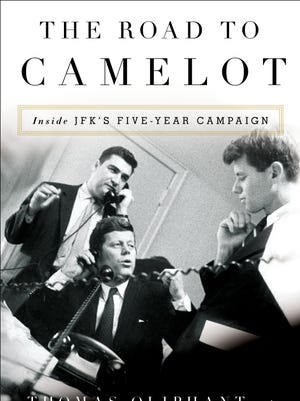New book: How JFK charted 'The Road to Camelot'

Followers of American political history are no doubt familiar with how John Kennedy got elected president in 1960, particularly the influence of his rich father, Joseph Kennedy, and the favorable comparisons between the handsome senator from Massachusetts and his opponent, Republican Vice President Richard Nixon.
Kennedy looked cool on television; Nixon looked haggard. A national desire for vigor in the Oval Office after eight years of Dwight Eisenhower pushed Kennedy into the White House in a razor-thin election victory.
The accepted wisdom, however, underestimates Kennedy's role in engineering his election, authors Thomas Oliphant and Curtis Wilkie write in their new book The Road to Camelot: Inside JFK's Five-Year Campaign (Simon & Schuster, 448 pp., **** out of four stars).
The future president, they show, was not just a political ingenue known for his beautiful young wife and record as a World War II naval hero. Instead, the Jack Kennedy described here started his move to the White House by turning a loss into a win. He sought the Democratic nomination for vice president in 1956 with Adlai Stevenson, but lost in an open convention vote.
"His campaign was not a scripted operation but a long, continuous pursuit," Oliphant and Wilkie write. "At first it was tentative, with Kennedy appearing detached, even doubtful. But by the end of the summer of 1956 Kennedy felt the presidency was staring him in the face. On Thanksgiving that year he made the commitment to start running."

Longtime reporters for The Boston Globe, Oliphant and Wilkie excel here in taking the accepted knowledge of Kennedy's rise, debunking some of the conventional wisdom (such as Joe Kennedy's role as his son's Svengali) and adding new details that provide a richer history of our 35th president.
They also rap Kennedy for his accommodations to southern Democrats who were notoriously against civil rights, showing how the Massachusetts Democrat was willing to tolerate their racism in order to get elected, "an extraordinary exercise, a tightrope walk between the southern forces and a civil rights movement beginning to gather momentum."
Oliphant and Wilkie also trash the myth that Nixon magnanimously acknowledged the close election by showing how Nixon went along with Republican attempts to challenge the results.

"But Nixon's narrative is false," they write. "When (Republican chairman Thruston) Morton outlined his plans, Nixon could have stopped him on the spot with a simple, forceful request. He didn't, making him tacitly complicit in what followed."
The authors' knowledge of politics, campaigns and the presidency crackles off each page. They touch all the Kennedy bases here, detailing the roles played by Robert Kennedy, the candidate's brother, as well as aides Theodore Sorenson, Lawrence O'Brien and others. Oliphant and Wilkie also give life to long-forgotten players in Massachusetts politics, such as former state Democratic Party chairman William "Onions" Burke, a western Massachusetts onion farmer whom Kennedy ousted during a contentious 1956 party convention.
They take Kennedy from his time as a relative lightweight with a thin Senate resume to an iconic president, which makes The Road to Camelot a must-read for fans of presidential history.
—————
Ray Locker is the Washington enterprise editor of USA TODAY and author of Nixon's Gamble: How a President's Own Secret Government Destroyed His Administration.